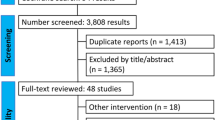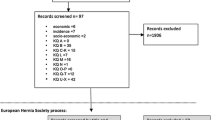Abstract
Background
Prosthetic reinforcement is the gold standard treatment for inguinal hernia and reduces the risk of recurrence. Yet up to one-third of patients complain of post-surgical pain due to irritation and inflammation caused by the mesh and the fixation materials. Of these patients, 3–4% will experience severe and disabling chronic pain. We performed a prospective multicenter clinical study of a self-adhering prosthesis, consisting of a lightweight polypropylene mesh (40 g/m²) coated on each side with synthetic glue, to evaluate early postoperative complications and patient outcomes.
Patients and methods
Between August 2008 and June 2010, 186 patients underwent hernia repair using the Lichtenstein technique and the self-adhering prosthesis. Primary endpoints were the frequency of disabling complications and quality of life (QoL) at 3-month follow-up. Pain, numbness, and groin discomfort were evaluated pre- and postoperatively (1 week, 1 and 3 months) using a visual analogue scale (VAS). Patients' pre- and postoperative QoL were measured using the SF12 questionnaire. Secondary endpoints were number of complications and recurrence rate, use of analgesic drugs, length of hospital stay, delay to return to normal activities, and patient satisfaction. The quality of the self-adhering mesh and its clinical utility were also evaluated by the participating surgeons.
Results
A total of 186 patients were enrolled and followed for at least 3 months after inguinal hernia repair. A total of 174 (95%) primary hernias and 12 (5%) recurrent hernias were treated. There were no intraoperative complications, no recurrences, and no repeat interventions performed during the study. The post-surgical complication rate was 4.5%. The mean delay to recover normal physical activity was 4 days. For the primary endpoint of pain, a VAS of zero was reported by 93/184 (50.5%) patients at 1 week, 130/171 (76.0%) patients at 1 month and 119/132 (90.2%) patients at 3 months’ follow-up (P < 0.0001). The postoperative SF12 scores showed a significant improvement in patient QoL following surgery (P < 0.0001).
Conclusions
Adhesix® self-adhering mesh for prosthetic reinforcement following inguinal hernia repair is atraumatic and associated with infrequent post-surgical complications or pain, a rapid recovery rate, and a high patient-reported QoL. A longer follow-up is underway to assess the frequency of post-surgical recurrence.
Similar content being viewed by others
References
Poolbalan AS, Bruce J, King PM, Chamber VA, Krukowski ZH, Smith WCS (2003) A review of chronic pain after inguinal herniorrhaphy. Clin J Pain 19:48–54
Bay-Nielsen M, Perkins FM, Kehlet M (2001) Pain and functional impairment 1 year after inguinal herniorrhaphy: a nationwide questionnaire study. Ann Surg 233:1–7
Bringman S, Wollert S, Osterberg J, Smedberg S, Grandlund H, Heikkinen T (2006) Three-year results of a randomized clinical trial of lightweight or standard polypropylene mesh in Lichtenstein repair of primary influence hernia. Br J Surg 96:1056–1059
Kumar S, Wilson RG, Nixon SJ, Maatire IM (2002) Chronic pain after laparoscopic and open mesh repair of groin hernia. Br J Surg 89:1476–1479
Schwab R, Willms A, Kroger A, Becker HP (2006) Less chronic pain following mesh fixation using a fibrin sealant in TEP inguinal hernia repair. Hernia 10:272–277
Champault G, Polliand C, Dufour F, Ziol M, Behr L (2009) A self adhering prosthesis for hernia repair: experimental study. Hernia 13:49–52
Miserez M, Alexandre JH, Campanelli G, Corcione F, Cuccurullo D, Pascual MH et al (2007) The European hernia society groin hernia classification: simple and easy to remenber. Hernia 11:113–116
Ware JE et al. (1993) Manual and interpretation guide, Lincoln, RI. Qualitymetric Incorporated (2000, 2004)
Ferzli GS, Edwards ED, Koury GE (2007) Chronic pain after inguinal herniorrhaphy. J Am Coll Surg 205:333–341
Dennis R, O’Riordan D (2007) Risk factors for chronic pain after inguinal hernia repair. Ann R Coll Surg Engl 89:218–220
Heise CP, Starling JR (1998) Mesh inguinodynia: a new clinical syndrome after inguinal herniorrhaphy. J Am Coll Surg 187:514–518
Klinge U, Kosterhalfen B, Müller M, Shumpelick V (1999) Foreign body reaction to meshes used for the repair of abdominal wall hernias. Eur J Surg 165:665–673
Chevrel JP, Rath AM (1997) The use of fibrin glues in the surgical treatment of incisional hernias. Hernia 1:9–14
Katkouda N, Mavor E, Friedlander MH, Mason RJ, Kiyabu M, Grant SW, Achanta K, Kirkman EL, Narayanan K, Essani R (2001) Use of fibrin sealant for prosthetic mesh fixation in laparoscopic extra peritoneal inguinal hernia repair. Ann Surg 233:18–25
Canonico S, Santoriello A, Campitiello F, Fallopace A, Dellacorte A, Sordelli I, Benevento R (2005) Mesh fixation with human fibrin glue (Tissucol) in open tension free inguinal hernia repair. A preliminary report. Hernia 9:330–333
Fortelny RH, Schwab R, Glaser KS, Puchner KU, May C, Konig F, Redl H, Petter-Puchner AH (2008) The assessment of quality of life in a trial on light weight mesh fixation with fibrin sealant in trans-abdominal pre-peritoneal hernia repair. Hernia 12:499–505
Hanswijck Van, de Jonge P, Lloyd A, Horsfall L, Tan R, O’Dwyer PJ (2008) The measurement of chronic pain and health related quality of life following inguinal hernia repair: a review of the literature. Hernia 12:561–569
Poobalan AS, Bruce J, King PM, Chambers WA, Krukowski ZH, Smith WCS (2001) Chronic pain and quality of life following open inguinal hernia repair. Br J Surg 88:1122–1126
Champault G, Bernard C, Rizk N, Polliand C (2007) Inguinal hernia repair: the choice of prosthesis outweighs that of technique. Hernia 11:125–128
Acknowledgments
We are grateful to Pierre Clerson from Orgamétrie (23 Bd du Général Leclerc, 59100 Roubaix, France) for help with the statistical analyses and to Jean François Gury (Mulhouse), Laurent Bresler (Nancy), Jean Delaby (Angers), and Claude Polliand (Bondy) for their participation in the study. Funding Funding for this study was provided by the manufacturer Cousin Biotech. However, data management was performed by an independent contractor employed by the manufacturer (Orgamétrie P Clerson), and none of the investigators received a stipend from Cousin Biotech.
Author information
Authors and Affiliations
Corresponding author
Additional information
A self-adhering mesh: Adhésix®—Laboratoires Cousin Biotech—59117 Wervicq Sud (France).
Rights and permissions
About this article
Cite this article
Champault, G., Torcivia, A., Paolino, L. et al. A self-adhering mesh for inguinal hernia repair: preliminary results of a prospective, multicenter study. Hernia 15, 635–641 (2011). https://doi.org/10.1007/s10029-011-0843-8
Received:
Accepted:
Published:
Issue Date:
DOI: https://doi.org/10.1007/s10029-011-0843-8




